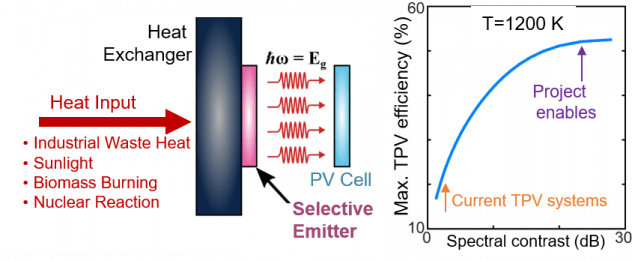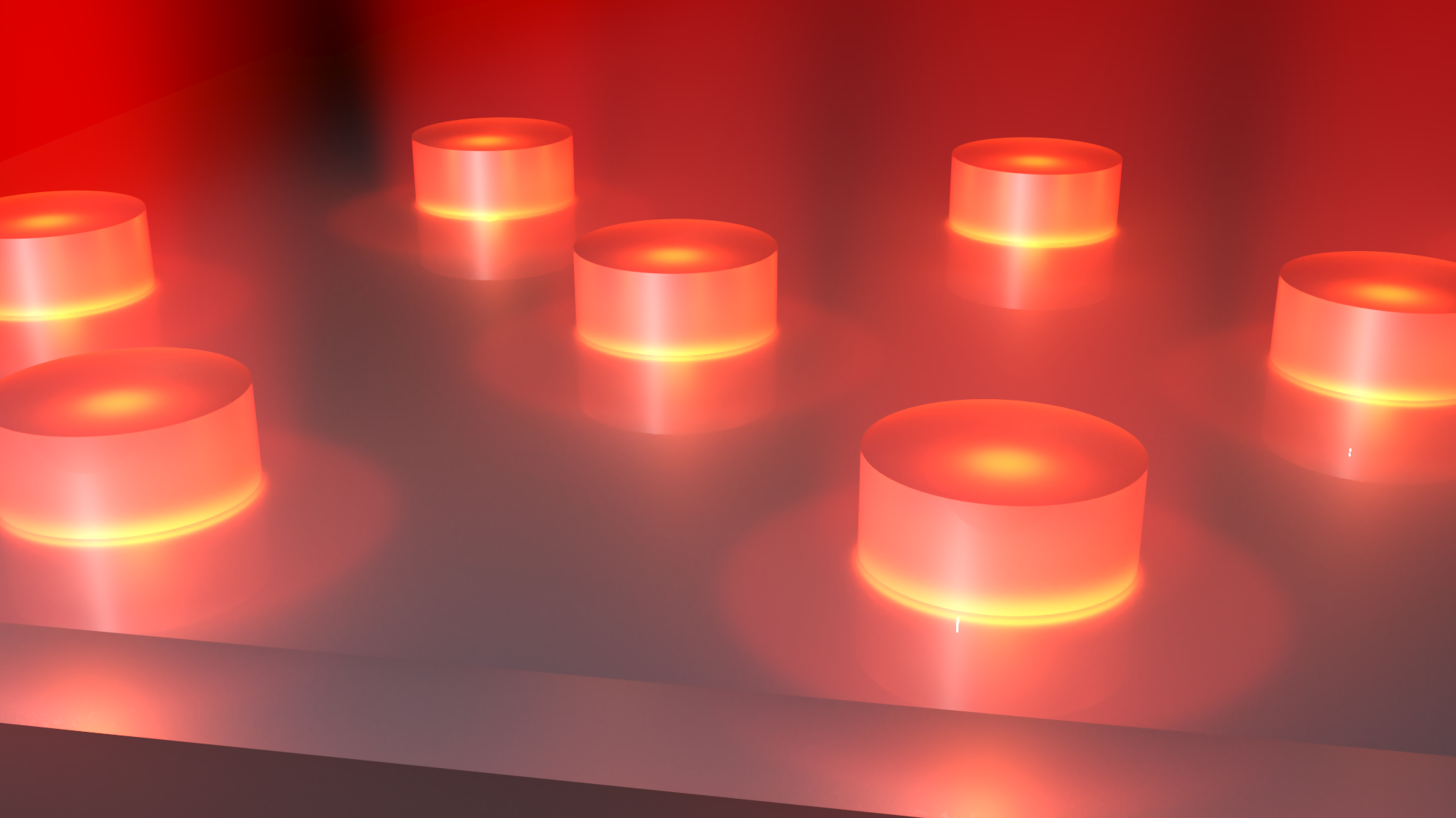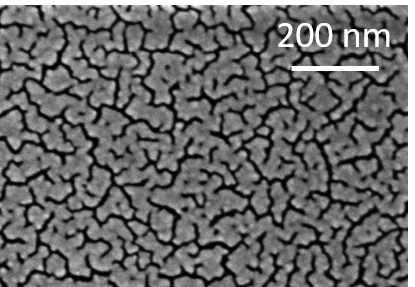Nanophotonics in the past has relied mostly on the classical picture of light. On the other hand, the quantum treatment of light in nanoscale devices is challenging because of inevitable losses. Hence, quantum optics has remained mostly in the micron-scale. Thus, nanophotonics was yet to take advantage of powerful design tools of the quantum world – phase, symmetry, and topology. The Naik lab addresses this gap between quantum optics and nanophotonics. We study quantum phase transitions and the interaction of light with quantum materials to solve societal challenges in energy, imaging, and information security.
Non-Hermitian Thermal Emitters for Efficient Energy Conversion
The broad bandwidth of solar radiation is a major obstacle for high-efficiency photovoltaic (PV) technology. Thermophotovoltaics (TPV) is a promising alternative for squeezing broadband solar radiation into a narrow spectral band. TPV systems can not only improve the efficiency of light-harvesting but also expand the scope of existing PV technology to harvest heat. Though TPV conversion is promising for future energy technologies, the demonstrated conversion efficiencies are low. Theoretical estimates suggest a TPV conversion efficiency of 80% should be possible. However, experimental demonstrations have not crossed 12%. The major challenge in realizing high-efficiency TPV is in designing high contrast, broadband suppression, spectrally selective emitters capable of operating at high temperatures. Here in this project, we address this challenge in a unique way, by combining nanophotonics with non-Hermitian physics to design spectrally selective thermal emitters.
Conventional spectrally selective emitters are built from a collection of nano-optical resonators where each resonator satisfies the overall specification of the device. Thus, tight constraints on the device translate to severely tight constraints on the resonators. However, a quantum optical description of the same system allows coherent interaction between individual resonators and provides new design tools to achieve the same device specifications. Here, the collective behavior of the system shares the burden of tight device specifications allowing more practical resonator designs. The quantum optical description of open systems such as a thermal light source requires non-Hermitian physics, and this project employs it. The project aims to investigate the new design tools that arise from a non-Hermitian description of thermal emitters and build efficient TPV converters.
Relevant papers:
Semiconductors for high selectivity thermal emitters,” Journal of Optics, vol. 20, no. 8, p. 084001, 2018.
“Optimum selective emitters for efficient thermophotovoltaic conversion,” Applied Physics Letters, vol. 116, p. 023903, 2020.
“Macroscopically aligned carbon nanotubes as a refractory platform for hyperbolic thermal emitters,” ACS Photonics, vol. 6, no. 7, pp. 1602-1609, 2019.
Topological Thermal Emitters for Imaging
Thermal imaging in small spectral bands can be challenging because the sensor could easily be flooded by

thermal photons from the sensor and imaging optics. Optical elements with directional thermal emission mitigate the problem. We design windows with directional thermal emission using the concepts of non-Hermitian physics. Non-Hermitian physics allows the coupling of multiple nanophotonic resonators with different absorption losses. Such systems do exhibit non-trivial topological properties. The non-trivial topology of non-Hermitian systems allows directional emission of thermal light. We investigate the topological properties of non-Hermitian nanophotonic systems and design directional thermal emitters for imaging applications.
Relevant papers:
“Non‐Hermitian selective thermal emitters using metal-semiconductor hybrid resonators,” Advanced Materials, vol. 31, p. 19041542019, 2019.
Quantum Materials for Tunable Nanophotonics
 Quantum materials or strongly correlated materials possess a complex energy landscape and multiple phase transitions arising from many-body interaction. Light can be a powerful tool in tipping the balance between competing interaction mechanisms. Such quantum materials can exhibit gigantic sensitivity to stimuli including light and hence are promising for emerging optical applications such as 3D displays and imaging. We discovered a fascinating optical phenomenon in a charge-ordered material, 1T-TaS2, at room temperature. Its c-axis refractive index changed by unity order under a DC bias, an AC bias, and an incoherent white light illumination of about 1-Sun intensity. Probing the mechanism of tuning revealed that the charge density domains across layers rearrange with illumination and thereby tune the electronic and optical properties. Our discovery suggests that stacking order is an essential dimension in the phase diagram of quantum materials, and ambient light could be sufficient to control it. Further, many new light-induced phenomena could be possible in 1T-TaS2, and we are currently investigating their possibility. Exploring such light-induced phenomena in quantum materials, especially under low-intensity illumination, is the focus of this research direction.
Quantum materials or strongly correlated materials possess a complex energy landscape and multiple phase transitions arising from many-body interaction. Light can be a powerful tool in tipping the balance between competing interaction mechanisms. Such quantum materials can exhibit gigantic sensitivity to stimuli including light and hence are promising for emerging optical applications such as 3D displays and imaging. We discovered a fascinating optical phenomenon in a charge-ordered material, 1T-TaS2, at room temperature. Its c-axis refractive index changed by unity order under a DC bias, an AC bias, and an incoherent white light illumination of about 1-Sun intensity. Probing the mechanism of tuning revealed that the charge density domains across layers rearrange with illumination and thereby tune the electronic and optical properties. Our discovery suggests that stacking order is an essential dimension in the phase diagram of quantum materials, and ambient light could be sufficient to control it. Further, many new light-induced phenomena could be possible in 1T-TaS2, and we are currently investigating their possibility. Exploring such light-induced phenomena in quantum materials, especially under low-intensity illumination, is the focus of this research direction.
Relevant papers:
“Large Optical Tunability from Charge Density Waves in 1T-TaS2 under Incoherent Illumination,” Nano Letters, vol. 20, no. 11, pp. 7868-7873, 2020.
“In-plane electrical bias tunable optical properties of 1T-TaS₂,” Optical Material Express, vol. 9, no. 2, pp. 497-503, 2019.
Stochastic Networks for Lightweight and Secure Authentication
Authenticating the billions of ubiquitous devices is one of the fundamental and universal security primitives to establish security in a plethora of emerging IoT and healthcare applications. Strong Physically Unclonable Functions offer a solution to this problem. Implementing such a function using a stochastic network of conductors is the goal of this project. The project studies quantum phase transitions in such stochastic conductor systems for secure authentication.